Teaching and Learning with Technology
Teaching and Learning with Technology is a growing collection of articles on the Technology Integration Matrix, professional development and the TIM, TIM Tools, and research written by FCIT staff including Dr. J. Christine Harmes, our psychometrician; Dr. James Welsh, Director of the Florida Center for Instructional Technology; and Dr. Roy Winkelman, former FCIT Director who participated in the creation of the Technology Integration Matrix. These articles are intended to expand upon and supplement the Technology Integration Matrix itself, the individual TIM Tools pages, and the TIM Tools Admin Guide.
Section I:
The TIM
Section II:
The TIM and PD
Section III:
TIM Tools
Section IV:
Research
1. Background to the Technology Integration Matrix

Talking TIM: A Common Vocabulary. We often present the Technology Integration Matrix (TIM) as a “common vocabulary” for technology integration. We didn’t pick that phrase out of thin air. The TIM was developed to meet a specific, pressing need, although its utility as a “common vocabulary” expanded far beyond….
A Teenager in the House: TIM Turns 13! As the Technology Integration Matrix officially becomes a teenager, we take a look back at TIM’s formative years and speculate just a bit about the future. Originally published in 2005, the Technology Integration Matrix was produced by the Florida Center for Instructional….
2. Five Characteristics of a Meaningful Learning Environment
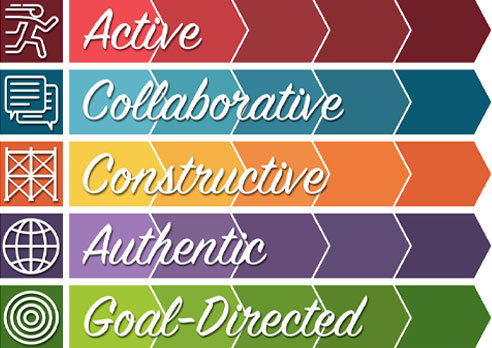
Active Learning: Engaging Students’ Minds. The Active characteristic makes the distinction between lessons in which students passively receive information and lessons in which students discover, process, and….
Collaborative Learning: Building Knowledge in Community. A successful collaborative learning environment doesn’t happen overnight. There’s a sense in which it’s both the hardest and the easiest….
Constructive Learning: Making Connections. The Constructive characteristic describes instruction in which students to use technology tools to connect new information to their existing knowledge….
Authentic Learning: Mirroring the Real World. Students are more likely to be interested in what they are learning, more motivated to learn new concepts and skills, and better prepared to succeed….
Goal-Directed Learning: Escape from the “Schoolwork Box”. When learners are actively and willfully trying to achieve a cognitive goal, they think and learn more because they are fulfilling an intention….
3. Understanding Levels of Technology Integration
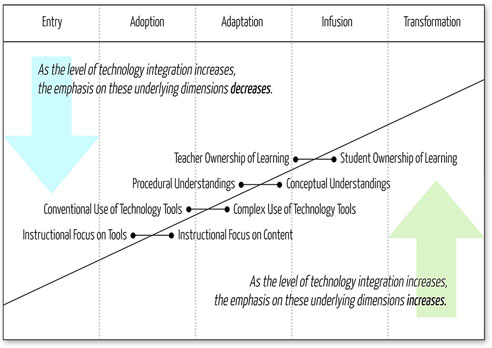
The Invisible Technology Integration Matrix. There are also some “invisible” dimensions to the TIM. The invisible dimensions underlie the movement from left to right….
Why does the TIM have 5 levels? Real professional growth is a process. There are many steps along the way. To try to understand those steps, we reviewed academic literature, we observed classrooms….
Tech Exploration in the Classroom. The emphasis on not only allowing, but also encouraging, exploration is no accident. In our busy schedules we….
What do we mean by “independent access”? The spirit of independent use is that a student can evaluate a situation and choose the hardware or software that the student thinks will be most….
Ownership of Learning with Technology. One of the most important concepts behind the TIM is the ownership of learning. At lower levels of….
Eight Great Habits for Learning with Technology. Students who are self-directed, active learners and can leverage available technology for….
The TIM and Time Management. The essential elements of time management are already there in the Technology Integration Matrix. The first component of learning time management is learning how to….
Cybersecurity Education and the TIM. Nowadays, cybersecurity is definitely a moving target. Moving students to the higher levels of the TIM is one of the best ways to prepare them for whatever comes next….
When Old Tech Is Better. This article is a reminder that the pedagogically-sound use of technology is vastly more important than the age of the technology employed….
4. Technology Integration Models
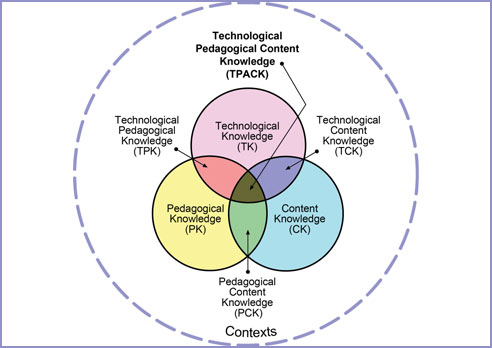
ISTE Standards and the TIM. The first article in this series introduces the notion of the relationship between aspirational standards and implementation frameworks….
Bloom’s Cognitive Taxonomy and the TIM. Bloom’s Cognitive Taxonomy is familiar to nearly every educator and broadly corresponds to levels of technology integration as defined in the TIM….
TPACK and the TIM. TPACK has its roots in work done in the 1980s by Lee Schulman who noted that is was not sufficient for teachers to know pedagogy and the content of their teaching area as two separate fields….
Universal Design for Learning and the TIM. UDL and the TIM share many areas of overlap, particularly around the concept of student choice….
SAMR and the TIM. The SAMR (Substitution, Augmentation, Modification, and Redefinition) model is the one that has the least overlap with the TIM and other models in this series….
Choosing Models and Modeling Choices. Which technology integration model is best? When considering models of technology integration, it is vital to consider the specific needs and goals of your school or district and the purposes and strengths of the models available….
5. Professional Development and the TIM

Introducing TIM to Your Teachers. A few principles and a ton of resources for introducing the TIM to your teachers….
TIM Instructional Planning Model. To help teachers achieve a balance curriculum demands, student needs, and technology integration, FCIT developed the TIM Instructional Planning Model….
Using the TIM to Support Teacher Reflective Practice. Reflection is essential to professional growth. If we stay in the weeds and remain focused on moving from task to task, we will continue doing things the same way we always have, not taking advantage of experiences and opportunities for making positive change….
Ramp Up Your PD Today. The TIM Tools provide a way to help you continue to offer embedded professional development through online classroom observations and feedback, remote lesson plan review, and online coaching and mentoring programs….
TIM PD Activity: Take It Up a Level. One way to get teachers past the “more tech makes better lessons” thinking is to ask them to adapt an existing lesson to move it up one level for any specific characteristic on the TIM. For example….
TIM PD Activity: Build a Matrix. This activity is designed to encourage teachers to think through the pedagogical principles underlying the TIM as they construct the Matrix themselves. Something they have thought through and constructed themselves is going to stick better….
Comfort and Confidence as Professional Development Goals. One approach for setting goals for an individual professional development plan or a coaching cycle is to identify an area in which the teacher lacks comfort or confidence. You might ask a teacher questions like these….
Ultimate Teaching Device. This tongue-in-cheek post reminds us that despite the abundance of technology, the ultimate teaching device is the teacher. Teacher-led, student-centered, technology-enhanced. Getting the order right makes all the difference….
6. Professional Development and the Technology Uses and Perceptions Survey

Using the TUPS to Target Professional Development. Results from the TUPS provide both a breadth and depth of information that can provide great insights at different levels for improving technology integration…
Nail Your Next Tech PD with the Quadrant Graph. Wouldn’t it be great if we had a quick way of viewing our district’s PD needs and we could identify teachers who would get the most out of each type of training we offered? The TUPS Quadrant Graph within TIM Tools does just that….
Path Models and Technology Integration: A PD Cheat Sheet. There are many factors that impact the level of technology integration in a classroom. We want to take as many of these factors as possible into consideration when developing PD. This is the very opposite of the one-size-fits-all, one-and-done model of professional development that has little to no impact on teaching practice….
SIS IT Driver’s License. Leading international schools often face the problem of teachers who frequently move from school to school to experience different countries and cultures. The Stockholm International School has a clever approach to ensure that all their teachers are up to speed on technology integration….
How often should we administer the TUPS? The answer, of course depends entirely upon your purposes, the implementation timeline, and the professional development opportunities available to your teachers. Let’s look at some typical scenarios….
7. Using Your TUPS Data

The Technology Uses and Perceptions Survey and Excel. Even before using the TIM Tools analysis templates, an administrator can sort and filter TUPS spreadsheets to identify groups such as first year Math and Science teachers or teachers who are ready and willing to mentor peers in a particular skill….
Using TUPS Data: Individual Items. Before doing a deeper analysis of TUPS data, you may wish to examine individual items. These data points can be used as “points of pride” for parents, the community, and other stakeholders. They can also be shared internally with teachers to promote discussion and awareness, and to begin PD efforts on a positive note….
Working with TUPS Data: The First Read-Through. Suggestions for generating a TUPS report in the Report Tool and discovering what impressions and insights can be gleaned from a first read-through….
Using TIM Tools Data Analysis Templates. There are four ways of working with TUPS and other TIM Tools data: the built-in Report Tool, using an API, importing into a provided TIM Tools template, or importing into your own preferred statistical software. This article explains the TIM Tools template method….
Find the Coaches Hiding in Your TUPS Data. There are probably many more potential coaches lurking in your TUPS data than you are aware of. This article identifies the columns in your TUPS data download to focus on and provides a helpful replacement header row to simplify….
A Framework for Growth: A Story of TIM Implementation in Graphs. Sister John Paul Maher, O.P., principal of St. Michael School in Worthington, OH, describes how her school used the TUPS to document improved technology use, effective professional development, positive change in perceptions and comfort levels and increased skill sets that directly impacted the approach to instruction and resulting quality of student engagement in learning….
8. Getting the most from your TIM Observation Data
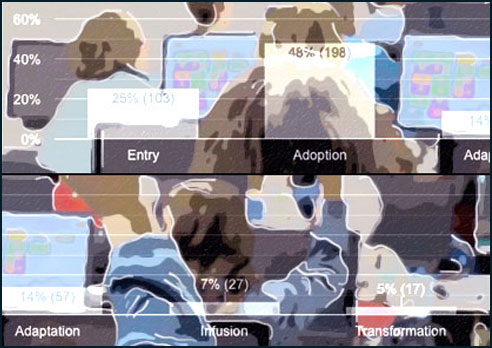
Extensity: A Teacher’s Highest Integration Level. How can you best use this Extensity distribution? It is especially powerful for planning professional development and for setting school or district-wide goals….
Highest Levels Observed: The High Watermark for an Observation. When viewed along side the other interpretive concepts, the graph of Highest Levels Observed can give you a more complete picture of what is typically occurring in classrooms in your school or district with regard to levels of technology integration….
Flexibility: A Teacher’s Range of Technology Integration Levels. Ideally, teachers would be able to deliver a lesson at every TIM level so that they are then able to target the level of integration that is most appropriate for a given lesson and group of students. The concept of Flexibility gives us an indication of the degree to which this has been demonstrated for each teacher, and then at the group level….
Level Prevalence: A Snapshot of Typical Teacher Classroom Technology Use. Level Prevalence gives us a value for each TIM characteristic, which can then be used to recommend characteristic-related PD for a particular group of teachers….
Characteristic Dominance: A Key to Targeting Professional Development. Characteristic Dominance identifies the characteristics of meaningful learning that received the highest and lowest ratings across a set of lesson observations….
9. Coaching with the TIM-C
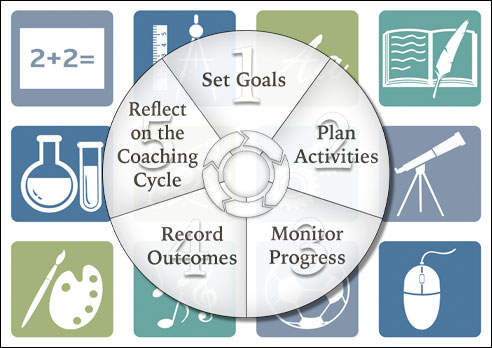
Using the TIM-C Coaching Tool. A coaching cycle is, at its most basic level, a structured conversation between a client and a coach, or between a mentor and a mentee. The TIM-C allows any two members within a TIM Tools instance to work together as coach and client irrespective of what role or title they may have….
A Coaching/Mentoring Tool for All Subject Areas. Although the Coaching Tool (or TIM-C for short) was created as a part of a tool set to support technology integration, there is nothing about the Tool itself that limits its use to technology coaching. If your school or district has licensed TIM Tools to support technology integration, any coaching program can also use the TIM-C for coaching or mentoring whether tech integration is a component of that program or not….
Find the Coaches Hiding in Your TUPS Data. There are probably many more potential coaches lurking in your TUPS data than you are aware of. This article identifies the columns in your TUPS data download to focus on and provides a helpful replacement header row to simplify….
The Beauty of Failure in Coaching. Learning from “failures” is a very important concept in our professional growth as educators. Just about the only way to avoid “failure” is to avoid growth, and that’s pretty much a failure in itself….
#COACHBETTER Spotlight. Kim Cofino at #COACHBETTER SPOTLIGHT interviews James Welsh regarding the five characteristics of effective educational technology from a coaching perspective….
10. Getting Started with TIM Tools

TIM Tools: Do I need a school or a district license? A TIM Tools subscription is available as either a school or a district license, but sometimes a school would be better off with a district license or a district can make a school license work for their project. Find out why….
TIM Tools: What level of license do I need? Use this checklist to determine what level of license you will need….
Implementing the TIM Tools: Planning for Impact. Just having a subscription to the TIM Tools isn’t enough. You have to use them. And to use them well and get good data you need a solid plan. Here are the key factors to a strong implementation….
Leveraging Your TIM Tools. TIM Tools support for online environments….
EdTech Consultants, PD Providers, and Exercise Bicycles. Sometimes tech directors are too busy putting out daily fires to make the most of their TIM Tools license. In those cases, it may make sense to bring in an outside consultant whose focus is solely on getting the most value from the Tools….
11. Customizing Your TIM Tools Site Appearance

Customize Your TIM Tools Site. There are three easily-customizable areas of your TIM Tools site that all users will see: your site banner, homepage layout, and the Teacher Center. Each provides an opportunity to make TIM Tools your own….
Site Banner Customization. Three changes to banner customization in version 7.0 of TIM Tools bring additional choices, zippier options, and more convenience to banner selection….
Custom Banners for Your TIM Tools Instance. While most TIM Tools clients use one of the 100 or so built-in page header images for their site, some clients prefer to make a custom banner to match their other websites or sometimes just their school colors. With just a few minutes effort you can….
12. Configuration Options within Your TIM Tools Site
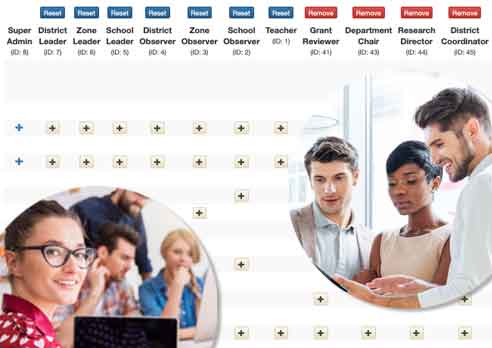
Rockin’ Roles in TIM Tools. Right out of the box, the TIM Tools admin center includes eight predefined user roles appropriate for most schools or districts. We developed the roles feature, however, to allow complete customization of roles should your school or district structure require it….
Using TIM Tools around the World. Suggestions for configuring the structure and roles to meet the needs of just about any type of school system….
TIM Tools in Higher Ed. Configuring TIM Tools to manage any combination of research projects, grant evaluations, and intern observations in a single “district” version of the software….
Regional Agencies, Associations, Consultants, and Others Who Manage TIM Tools on Behalf of Others. An Educational Service Agency administering a single TIM Tools instance on behalf of a group of districts or schools can provide significant cost savings, informed technology planning and purchasing decisions, bundled PD, and grant management support….
TIM Tools Application Programming Interface. Our TIM Tools Developer Center allows clients to register their developers and begin using the various APIs to pull TIM-LP, TIM-O, TIM-R, TIM-C, TUPS, and Survey Tool data directly into their own reporting systems….
Admin Guide at Your Service. The online TIM Tools Admin Guide makes it easy to find the information you’re looking for. We’ve broken the help files down into the sorts of tasks users are likely to ask about….
13. Managing Individual Tools

TUPS: Using Collection Frameworks. A collection framework is an administration of the TUPS for specific roles, in specific locations, and over a specific period of time. When a framework is created, all members whose role and location match the framework parameters will find….
TIM-O: How Many Observations Do I Need? In order to determine the optimal frequency for data collection, you first need to ask another question: “What will I do with the data once I have it?” You might also….
Ten Tips for TIM-O Observers. Whether you are an administrator, coach, or peer teacher called to observe a lesson, here are ten tips for an effective lesson observation using the Technology Integration Matrix Observation tool (TIM-O)…
ARTI: Three ARTI Scenarios. ARTI (Action Research for Technology Integration) helps teachers to structure and record AR projects while it helps TIM Tools clients to access and make use of the research findings from classrooms across their school or district….
Survey Tool: Quick and Easy Check-Ins. In the library within the Survey Tool (part of the TIM Evaluation Tools) we created a set of quick check-ins for your use. You can modify them to meet your needs, or use them as is….
Survey Tool: Overcome Survey Fatigue with Cute Robots. If your school or district is sending out frequent surveys to parents and other stakeholders, you may find that adding appropriate images at the beginning and throughout your survey actually increases not only the overall response rate, but also the quality of the responses….
Survey Tool: Quick Surveys on the Fly. Your TIM Tools instance already “knows” the role and location of each teacher, administrator, or staff member you’ve entered into the system, so it’s easy to create an internal survey and then designate the role(s) and location(s) of the members it will be made available to….
Survey Tool: Survey Library Additions. If you’ve created a form or survey within the Survey Tool that you think may benefit others and you’re willing to share, please contact us. We’d love to receive your permission to add it to the central library of surveys that can be cloned and adapted by other TIM Tools users….
14. Using the TIM in Research

TIM-Powered Research and Evaluation. In contrast to some other models of technology integration that focus on specific tools or tasks, the TIM can help you reveal the answer to whether or not a research effort or program it is positively impacting teaching and learning. Here are a few ways that the TIM and TIM Tools can be used in your research and evaluation studies, along with an example for each general approach….
Leveraging TIM Tools Roles for Research and Evaluation. The addition of customizable roles in TIM Tools has made it convenient to create and track different groups when evaluating technology initiatives, PD programs, or other interventions….
TIM Tools for Dissertation Research. The Technology Integration Matrix is frequently used as a theoretical framework in studies of classroom technology integration because it is uniquely situated as a leveled model that focuses on the pedagogical dimensions of technology use. In addition to the TIM Tools built-in reporting, all data can be easily exported from TIM Tools in a format that is easily imported into SAS, SPSS, NVivo, Atlas.ti, or any standard quantitative or qualitative analysis software….
Do you have questions about the TIM or TIM Tools? Email us at TIM@fcit.us. You can also request a complimentary consultation about using TIM Tools in your school or district.
